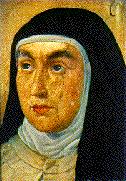Readings:
1 Samuel 3:1-18
Psalm 42:1-7
Romans 8:22-27
Mark 1:35-39Preface of Baptism
[Common of a Theologian and Teacher]
[Common of a Monastic or Professed Religious]
[Of the Incarnation]
PRAYERS (traditional language)
O God, who by thy Holy Spirit didst move
Teresa of Avila to manifest to thy Church the way of perfection: Grant
us, we beseech thee, to be nourished by her teaching, and enkindle
within us a lively and unquenchable longing for true holiness; through
Jesus Christ, the joy of loving hearts, who with thee and the same Holy
Spirit liveth and reigneth, one God, for ever and ever. Amen.
PRAYERS (contemporary language)
O God, by your Holy Spirit you moved Teresa
of Avila to manifest to your Church the way of perfection: Grant us, we
pray, to be nourished by her teaching, and enkindle within us
a keen and unquenchable longing for true holiness; through Jesus Christ,
the joy of loving hearts, who with you and the Holy Spirit lives and reigns,
one God, for ever and ever.
Amen.
Lessons revisd at General Convention 2024.
Return to Lectionary Home Page
Webmaster: Charles Wohlers
Last updated: 17 August 2024
TERESA OF AVILA
REFORMER AND CONTEMPLATIVE (15 OCT 1582)
 Teresa
de Cepeda y Ahumada (later known as Teresa de Jesus) was born in Avila,
Spain, 28 March 1515, one of ten children whose mother died when she was
fifteen. Her family was of partly Jewish ancestry. Teresa, having read
the letters of Jerome, decided to become a nun, and when she was 20, she
entered the Carmelite convent in Avila. There she fell seriously ill,
was in a coma for a while, and partially paralyzed for three years. In
her early years as a nun, she was, by her account, assiduous in prayer
while sick but lax and lukewarm in her prayers and devotions when the
sickness had passed. However, her prayer life eventually deepened, she
began to have visions and a vivid sense of the presence of God, and was
converted to a life of extreme devotion.
Teresa
de Cepeda y Ahumada (later known as Teresa de Jesus) was born in Avila,
Spain, 28 March 1515, one of ten children whose mother died when she was
fifteen. Her family was of partly Jewish ancestry. Teresa, having read
the letters of Jerome, decided to become a nun, and when she was 20, she
entered the Carmelite convent in Avila. There she fell seriously ill,
was in a coma for a while, and partially paralyzed for three years. In
her early years as a nun, she was, by her account, assiduous in prayer
while sick but lax and lukewarm in her prayers and devotions when the
sickness had passed. However, her prayer life eventually deepened, she
began to have visions and a vivid sense of the presence of God, and was
converted to a life of extreme devotion.
In 1560 she resolved to reform the monastery that had,
she thought, departed from the order's original intention and become insufficiently
austere. Her proposed reforms included strict enclosure (the nuns were
not to go to parties and social gatherings in town, or to have social
visitors at the convent, but to stay in the convent and pray and study
most of their waking hours) and discalcing (literally, taking off one's
shoes, a symbol of poverty, humility, and the simple life, uncluttered
by luxuries and other distractions). In 1562 she opened a new monastery
in Avila, over much opposition in the town and from the older monastery.
At length Teresa was given permission to proceed with her reforms, and
she travelled throughout Spain establishing seventeen houses of Carmelites
of the Strict (or Reformed) Observance (the others are called Carmelites
of the Ancient Observance). The reformed houses were small, poor, disciplined,
and strictly enclosed. Teresa died 4 October 1582. (She is commemorated
on the 15th--why not the 14th, I wonder--because the Pope changed the
calendar from the Julian to the Gregorian system, a difference of 10 days,
on the day after her death.)
Teresa is reported to have been very attractive in
person, witty, candid, and affectionate. She is remembered both for her
practical achievements and organizing skill and for her life of contemplative
prayer. Her books are read as aids to the spiritual life by many Christians
of all denominations. Her Life
is her autobiography to 1562; The
Way of Perfection is a treatise on the Christian walk, written
primarily for her sisters but of help to others as well; The Book of
Foundations deals with establishing, organizing and overseeing the
daily functioning of religious communities; The
Interior Castle (or The Castle of the Soul) deals
with the life of Christ in the heart of the believer. Most of these are
available in paperback. 31 of her poems and 458 of her
letters survive. Her feast day in the Roman Catholic Church is 15
October. The Lutheran Church (ELCA) commemorates her on December 14 together
with St. John of the Cross.
Christ has no body now but yours
No hands, no feet on earth but yours
Yours are the eyes through which He looks
compassion on this world
Christ has no body now on earth but yours.